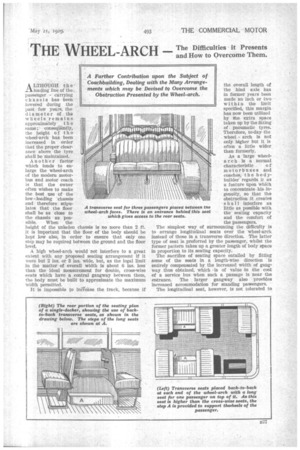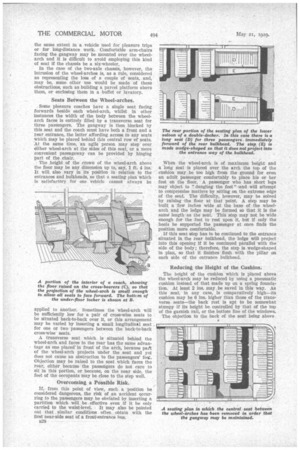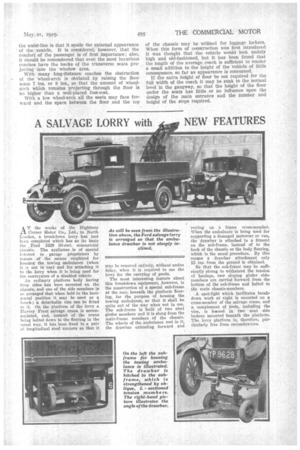THE WHEEL-ARCH
Page 53

Page 54

Page 55

If you've noticed an error in this article please click here to report it so we can fix it.
ALTHOUGH the iljoadiug line of the passenger carrying chassis has been lowered during the past few years, the dime ter Of tlica
a wheels remains approximately t h e same ;consequently, the height of the wheel-arch has been increased in order that the proper clearance above the tyre shall be maintained.
Another factor which tends to enlarge the wheel-arch of the modern motorbus and motor coach is that the owner often wishes to make the best use of the low loading chassis and therefore stipulates that the floor shall be as close to the chassis as possible. When the
height of the unladen chassis is no more than 2 ft. it is important that the floor of the body should be kept low also, in order to ensure that only one step may be required between the ground and the floor level.
A high wheel-arch would not interfere to a great extent with any proposed seating arrangement if it were but 2 ins. or 3 ins, wide, but, as the legal limit in the matter of overall width is about 6 ins, less than the ideal measurement for double, cross-wise seats which have a central gangway between them, the body must be built to approximate the maximum Width permitted.
It is impossible to inc-fease the track, because if the overall length of the hind axle has in former years been made an inch or two wit hin the limit specified, this margin has now been utilised by the extra space taken up by the fitting of pneumatic tyres. Therefore, to-day, the wheel arch is not only higher but it is often a little wider than formerly.
As a 'large wheelarch is a normal characteristic o f motorbuses and coaches, the bodybuilder regards it as a feature upon whiCh to concentrate-his. ingenuity, so that the obstruction 1it createS shall interfere as little as possible with the seating capacity and the comfort of the passengers.
The simplest way of surmounting the difficulty is to arrange longitudinal seats over the wheel-arch instead of those in a transverse direction. The latter type of seat is preferred by the passenger, whilst the former pattern takes up a greater length of body space in proportion to its seating capacity.
The sacrifice of seating space entailed by fitting some of the seats in a length-wise direction is entirely compensated by the increased width of gangway thus obtained, which -is of value in the cost of a service bus when such a passage is near the entrance. The larger gangway also provides increased accommodation for standing passengers.
The longitudinal seat, however, is not tolerated to the same extent in a vehicle used for pleasure trips or for long-distance work. Comfortable arm-chairs facing the gangway may be mounted over the wheelarch and it is difficult to avoid employing this kind of seat if the chassis be a six-wheeler.
In the case of the two-axle chassis' however, the intrusion of the wheel-arches is, as a rule, considered as representing the loss of a couple of seats, and, may be, some other use would be made of these obstructions, such as building a parcel platform above them, or enclosing them in a buffet or lavatory.
Seats Between the Wheel-arches.
Some pleasure coaches have a single seat facing forwards beside each wheel-arch, whilst in other instances the width of the body between the wheelarch faces is entirely filled by a transverse seat for three passengers. The gangway is then blocked by this seat and the coach must have both a front and a rear entrance, the latter affording access to any seats which may be placed behind this central row of seats. At the same time, -an agile person may step over either wheel-arch at the sides of this seat, or a more convenient passageway can be provided by hinging part of the chair. The .height of .the crown of the wheel-arch above the floor may be any dimension up to, say, 1 ft. 4 ins.It will, also vary in its position in relation to the entrances and bulkheads, so that a seating plan which is satisfactory for one vehicle cannot always be applied to another. Sometimes the wheel-arch will be sufficiently low for a pair of cross-wise seats to be situated back-to-back over it, or this arrangement may be varied by inserting a small longitudintl seat for one or two passengers between the back-to-back cross-wise seats.
A transverse seat which is situated behind the wheel-arch and faces to the rear has the same advantage as one placed in front of the arch, because patt of the wheel-arch projects under the seat and yet does not cause an obstruction to the passengers' feat. Objection may be raised to the seat which faces the rear, either because the passengers do not care to sit in this portion, or because, on the near side, the feet of the occupants may be close to the step well.
Overcoming a Possible Risk.
If, from this point of view, such a position he considered dangerous, the risk of an accident occurring to the passengers may be obviated by inserting a partition whieh will be effective even if it be only carried to the waist-level. vIt may also be pointed out that similar conditions often obtain with the first near-side seat of a front-entrance bus.
B28
When the wheel-arch is of maximum height and a long seat is placed over the arch the top of the cushion may be too high from the ground for even an adult passenger comfortably to place his or her feet on the floor. A passenger who has short legs , may object to "dangling the feet" and will attempt to compromise matters by sitting on the extreme edge of the seat. The difficulty, however, may be solved by raising -the floor at that point. A step may be built a few inches wide at the base of the wheelarch and the ledge may be formed so that it it the same length as the seat. This step may not be wide enough for the feet to rest upon it, but if only the heels be supported the passenger at once finds the position more comfortable.
If this seat step has to be continued to the entrance situated in the rear bulkhead, the ledge will project into this opening if it be continued parallel with the side of the body; therefore, the step is wedge-shaped in plan, so that it finishes flush with the pillar on each side of the entrance bulkhead.
Reducing the Height of the Cushion.
The height of the cushion which is placed above the wheel-arch may be reduced by using a pneumatic cushion instead of that made up on a spring foundation. At least 2 Ina may be saved in this way. As this seat, in any case, is comparatively high—its cushion may be 6 ins, higher than those of the transverse seats—the back rest is apt to be somewhat stumpy if its height be controlled by that of the top of the garnish rail, or the bottom line of the windows.
The objection to the back of the seat being above the waist-line is that it spoils the external appearance of the vehicle. It is considered, however, that the comfort or the passenger is of first importance; also, it should be remembered that ever. the most luxurious coaches have the backs of the transverse seats projecting into the window area.
With any long-distance coaches the obstruction of the Wheel-arch is obviated by raising the floor some 7 ins. or S ins., so that the amount of wheelarch which remains projecting through the floor is no higher than a well-placed foot-rest.
With a low wheel-arch all the seats may face forward and the space between the floor and the top of the chassis may be utilized for luggage lockers. When this form of construction was first introduced it was thought that the vehicle would look unduly high and old-fashioned, but it has been feund that the length of the average coach is sufficient to render a small addition to the height of the vehicle of little consequence, so far as appearance is concerned. If the extra height of floor be not required for the full width of the coach it may be sunk to the normal level in the gangway, so that the height of the floor under the seats has little or no influence upon the design of the main entrance and the number and height of the steps required.




















































































































